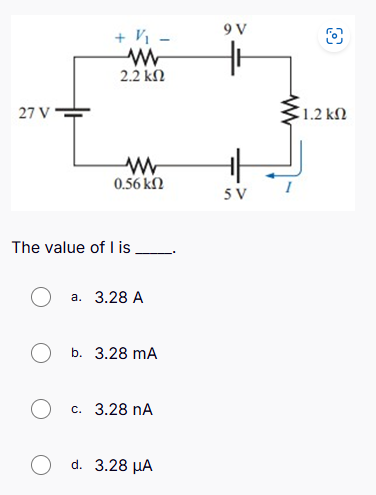The value of I is ____.

Understand the Problem
The question is asking to calculate the current (I) in a circuit with multiple resistors and voltage sources. To solve it, we can use Kirchhoff's laws and Ohm's law to analyze the circuit.
Answer
The value of $I$ is approximately $3.82 \text{ mA}$.
Answer for screen readers
The value of $I$ is approximately $3.82 \text{ mA}$.
Steps to Solve
- Identify the circuit components
The circuit has two voltage sources (27 V, 9 V, and 5 V), and three resistors (2.2 kΩ, 0.56 kΩ, and 1.2 kΩ). We'll use Kirchhoff's voltage law (KVL) to analyze it.
- Apply Kirchhoff’s voltage law
According to KVL, the sum of the voltage drops in the circuit should equal the sum of the voltage sources. Starting from the 27 V source and moving around the loop, we can set up the equation:
$$ 27 \text{ V} - I \cdot 2.2 \text{ k}\Omega - I \cdot 1.2 \text{ k}\Omega - 9 \text{ V} - 5 \text{ V} = 0 $$
- Combine resistances
Before solving, combine the resistances in series as follows:
$$ (R_1 + R_2) = (2.2 \text{ k}\Omega + 1.2 \text{ k}\Omega) = 3.4 \text{ k}\Omega $$
This gives us:
$$ 27 \text{ V} - I \cdot 3.4 \text{ k}\Omega - 14 \text{ V} = 0 $$
- Rearrange the equation
Rearranging this gives:
$$ I \cdot 3.4 \text{ k}\Omega = 27 \text{ V} - 14 \text{ V} $$ $$ I \cdot 3.4 \text{ k}\Omega = 13 \text{ V} $$
- Solve for I
Now, isolate the current $I$:
$$ I = \frac{13 \text{ V}}{3.4 \text{ k}\Omega} $$
Convert 3.4 kΩ to ohms:
$$ 3.4 \text{ k}\Omega = 3400 \text{ Ω} $$
So we get:
$$ I = \frac{13}{3400} $$ $$ I \approx 0.00382 \text{ A} = 3.82 \text{ mA} $$
- Convert the answer to the appropriate unit
Converting to milliamps gives:
Thus,
$$ I \approx 3.82 \text{ mA} $$
The value of $I$ is approximately $3.82 \text{ mA}$.
More Information
This question involves applying Kirchhoff's laws and Ohm's law to solve for current in a resistor network. Understanding circuit analysis and the importance of voltage sources is crucial for such problems.
Tips
- Mixing up the polarity of voltage sources can lead to incorrect answers.
- Failing to convert units appropriately can cause errors in the final calculation.
- Not adhering to the correct order of operations when solving equations can lead to mistakes.
AI-generated content may contain errors. Please verify critical information